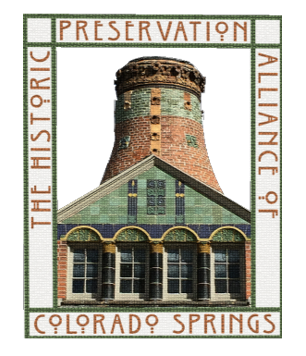[av_one_full first min_height=” vertical_alignment=” space=” custom_margin=” margin=’0px’ padding=’0px’ border=” border_color=” radius=’0px’ background_color=” src=” background_position=’top left’ background_repeat=’no-repeat’ animation=” mobile_display=”]
[av_textblock size=” font_color=” color=” admin_preview_bg=”]
 Endangered Places
Endangered Places
Pastorius Residence
702 N. Cascade Ave.
Circa: 1901
Late Victorian/Queen Anne/Half-Timbered. 1901 This house is significant for its association with the development of North Cascade as a residential area with several substantial residences during the Cripple Creek boom. Iit is the “only remaining Cripple Creek era mansion south of Colorado College still in single-family use on its original lot.”
The 1901 house is closely associated with Francis D. Pastorius, president of the Colorado Investment & Realty Co., prominent realtor and investor, and a founder of the Colorado Springs Garden Club. Pastorius built the house and lived here with his family. Victor Hungerford married Mary Pastorius and served as mayor of Colorado Springs during the period he lived here (ending in 1949).
The house is significant for its architecture, as an elaborate example of the half-timbered version of the Queen Anne style and notable for its gables with stucco and half-timbering, embedded mineral specimens; shingled walls; sash and transform window with lattice in transoms; porch with columns brackets, and Queen Anne balustrade; and stone foundation, as well as a variety of other embellishments.
The interior of the house is also reported to be of significance, being elaborately ornamented and unaltered.
Last photo on the right shows a picnic area in the lower level secret garden, accessed by a tunnel from the basement of the main house. The exit from the tunnel is below the banner.
The property is especially significant for its landscape architecture, which includes a high stone wall at the rear, unimpeded views of the mountains to the west, secret garden one street level below the main house and accessed through a long Dawson stone tunnel.
The garden is very important to history of landscape architecture in the city; it was cited as a show place of the region in 1926.
National Register eligible.
[/av_textblock]
[/av_one_full][av_one_full first min_height=” vertical_alignment=” space=” custom_margin=” margin=’0px’ padding=’0px’ border=” border_color=” radius=’0px’ background_color=” src=” background_position=’top left’ background_repeat=’no-repeat’ animation=” mobile_display=”]
[av_image src=’https://hpasprings.org/wp-content/uploads/2017/01/transparency_300-25×300.png’ attachment=’35’ attachment_size=’medium’ align=’center’ styling=” hover=” link=” target=” caption=” font_size=” appearance=” overlay_opacity=’0.4′ overlay_color=’#000000′ overlay_text_color=’#ffffff’ animation=’no-animation’ admin_preview_bg=”][/av_image]
[/av_one_full]
